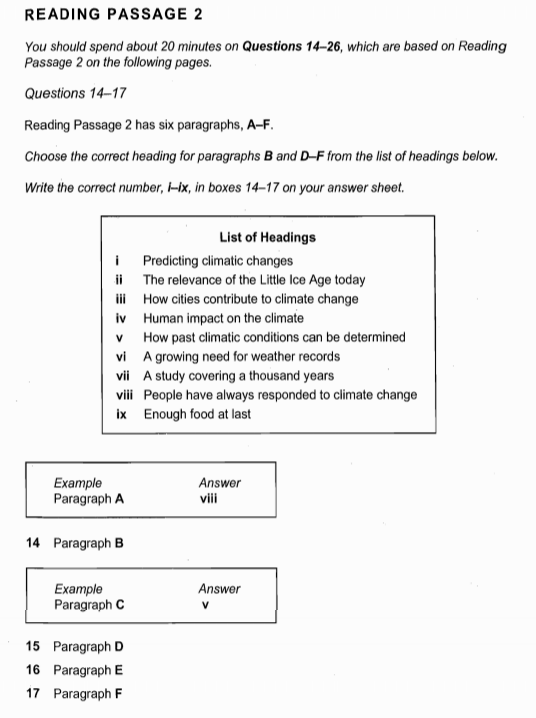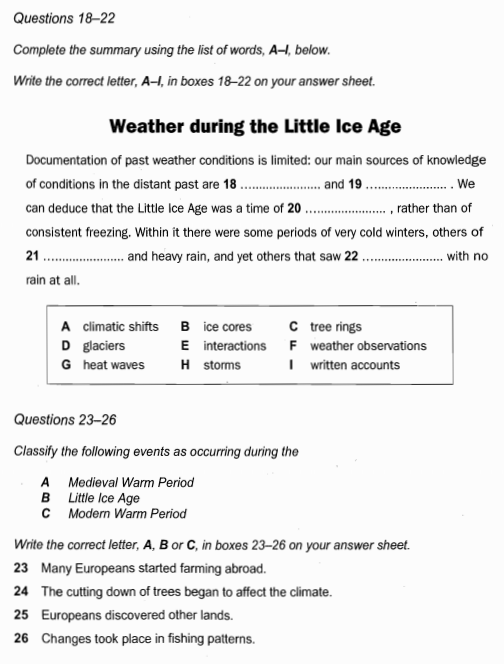剑桥雅思8阅读:Test4雅思阅读PASSAGE2真题+答案+解析
发布时间:2021-01-13 关键词:
THE LITTLE ICE AGE
A This book will provide a detailed examination of the ittle lce Age and other climaticshifts, but, before I embark on that, let me provide a historical context. We tend tothink of climate - as opposed to weather - as something unchanging, yet humanityhas been at the mercy of climate change for its entire existence, with at least eightglacial episodes in the past 730,000 years. Our ancestors adapted to the universalbut irregular global warming since the end of the last great lce Age, around 10,000years ago, with dazzling opportunism. They developed strategies for surviving
harsh drought cycles, decades of heavy rainfall or unaccustomed cold; adoptedagriculture and stock-raising, which revolutionised human life; and founded theworld's first pre-industríal civilisations in Egypt, Mesopotamia and the Americas.
But the price of sudden climate change, in famine, disease and suffering, was oftenhigh.
B The itie lce Age lasted from roughly 1300 until the middle of the nineteenthcentury. Only two centuries ago, Europe experienced a cycle of bitterly cold
winters; mountain glaciers in the Swiss Alps were the lowest in recorded memory,and pack ice surrounded lceland for much of the year. The climatic events of theLitle lce Age did more than help shape the modern world. They are the deeply
important context for the current unprecedented global warming. The ittle lce Agewas far from a deep freeze, however; rather an iregular seesaw of rapid climaticshifts, few lasting more than a quarter-century, driven by complex and still litlunderstood interactions between the atmosphere and the ocean. The seesaw
brought cycles of intensely cold winters and easterly winds, then switched abruptlyto .years of heavy spring and early summer rains, mild winters, and frequent Atlanticstorms, or to periods of droughts, light northeasterly winds, and summer heat
waves.
C Reconstructing the climate changes of the past is extremely dificult. becausesystematic weather observations began only a few centuries ago, in Europe andNorth America. Records from India and tropical Africa are even more recent.For the time before records began, we have only 'proxy records' reconstructedlargely from tree rings and ice cores, supplemented by a few incomplete writtenaccounts. We now have hundreds of tree-ring records from throughout the
northern hemisphere, and many from south of the equator, too, amplified with agrowing body of temperature data from ice cores rilled in Antarctica, Greenland,the Peruvian Andes, and other locations. We are close to a knowledge of annualsummer and winter temperature variations over much ol the northern hemispheregoing back 600 years.
D This book is a narrative history of climatic shifts during the past ten centuries, andsome of the ways in which people in Europe adapted to them. Part One describesthe Medieval Warm Period, roughly 900 to 1200. During these three centuries,
Norse voyagers from Northern Europe explored northern seas, settled Greenland,and visited North America. It was not a time of uniform warmth, for then, as alwayssince the Great lce Age, there were constant shifts in rainfall and temperature.Mean European temperatures were about the same as today, perhaps slightlycooler.
E Itis known that the itle lce Age cooling began in Greenland and the Arctic inabout 1200. As the Arctic ice pack spread southward, Norse voyages to the westwere rerouted into the open Atlantic, then ended altogether. Storminess increasedin the North Atlantic and North Sea. Colder, much wetter weather descended onEurope between 1315 and 1319, when thousands perished in a continent-widefamine. By 1400, the weather had become decidedly more unpredictable and.stormier, with sudden shifts and lower temperatures that culminated in the colddecades of the late sixteenth century. Fish were a vital commodity in growingtowns and cities, where food supplies were a constant concern. Dried cod andherring were already the staples of the European fish trade, but changes in watertemperatures forced fishing fleets to work further offshore. The Basques, Dutch,and English developed the first offshore fishing boats adapted to a colder andstormier Atlantic. A gradual agricultural revolution in northern Europe stemmedfrom concerns over food supplies at a time of rising populations. The revolutioninvolved intensive commercial farming and the growing of animal fodder on landnot previously used for crops. The increased productivity from farmland made
some countries slfufficient in grain and livestock and offered effective protectionagainst famine.
F Global temperatures began to rise slowly after 1850, with the beginning of theModern Warm Period. There was a vast migration from Europe by land-hungryfarmers and others, to which the famine caused by the Irish potato blight
contributed, to North America, Australia, New Zealand, and southern Africa.Millions of hectares of forest and woodland fell before the newcomers' axesbetween 1850 and 1890, as intensive European farming methods expanded
across the world. The unprecedented land clearance released vast quantities ofcarbon dioxide into the atmosphere, triggering for the first time humanly causedglobal warming. T emperatures climbed more rapidly in the twentieth century asthe use of fossil fuels proliferated and greenhouse gas levels continued to soar.The rise has been even steeper since the early 1980s. The Litlte lce Age has givenway to a new climatic regime, marked by prolonged and steady warming. At thesame time, extreme weather events like Category 5 hurricanes are becoming morefrequent.
为控制威胁农作物和人类健康的害虫,持续鲁莽地使用合成化学物已被证明适得其反。除 了造成广泛的生态系统紊乱,杀虫剂促进具抗药性、危害性极大的“超级害虫”的形成。
据粮农组织(FAO)最近的研究显示,超过 300 种农业害虫已对大量的有效化学物形成抗药 性。更别说那些会传播疾病的害虫了,大约 100 种这样的害虫已对现使用中的不同杀虫剂形成 免疫。
使用杀虫剂的一个明显缺陷是,杀死害虫同时也会消灭许多有益的非定标性的生物,这些生 物可控制害虫数量的过分增长。这样一来,就导致了农业生态学家所说的“跑步机综合征”。由 于害虫具有强大的繁殖能力和基因多样性,它们可抵抗合成化学物并繁殖具有抗药性的后代。
“跑步机综合征”所产生的破坏作用,中非的棉农有深刻的体会。上世纪四十年代早期,依 靠以杀虫剂为基础的密集农业取得了辉煌成就,棉农认为杀虫剂是农作物产量的不二选择。 四十年代中期,中非棉农每年会喷洒 8 次杀虫剂,到了五十年代中期,三个抗药性的新害虫突然 爆发繁殖,喷洒次数上升至每季度 28 次。
至六十年代中期,情况发生了让人担忧的转折。随着另外四种新害虫的出现后,用于杀虫剂 支出的费用占到棉花生产总支出的一半。七十年代早期,害虫的基因变得更强大了,棉农被迫每 季度喷洒农药达 70 次。
美国环保机构的研究表明,如今市场上大部分的杀虫剂被不充分的证据检测到含有可能导 致癌症、基因突变和其他对身体产生反作用的物质。美国自然资源保护委员会发现一连串使用 中的有害化学物中,DDT 是最常见的。
面对由于不加鉴别地使用杀虫剂导致危害升级,更有效的且有利生态的生物控制策略(涉及 有所选择地使用害虫的天敌)越来越受青睐,尽管目前来说这个新领域的潜力有限。相比其他 办法,生物控制的优势在于提供一个相对低成本的、持续的、副作用最小的控制系统。由负 责的话,生物控制是安全的,不产生污染,并可以自我分解。
位于班加罗尔的英联邦生物控制研究所(CIBC),在全球分布有实验室和野外站,是其中 一个最活跃的非商业研究机构,从事利用自然天敌来对付寄生物的害虫控制研究工作。同时, CIBC 也是全球生物制剂进出口票据交换所。
CIBC 成功使用一种墨西哥本土的象鼻虫来控制可恶的银胶菊,这种草对印度和澳大利亚 的农业和人类健康造成间接影响。类似的,由 CIBC 赞助的海德拉巴地区研究实验室(RRL), 现尝试用一种阿根廷象鼻虫消灭水葫芦。水葫芦是另一种危险杂草,对世界许多地方产生危害。 根据来自 RRL 的 Kaiser Jamil 女士所说,这种阿根廷象鼻虫不会攻击其他植物,一对成年虫能 在 4-5 天内杀死这个水葫芦。CIBC 同时也在改善繁殖寄生虫技术以捕食一种昆虫——这种昆虫啃食美国和印度的果树树叶。 下面的例子证明了生物控制是如何被有效利用的。上世纪六十年代,斯里兰卡繁茂的椰子。
树林被潜叶虫危害,在引进新加坡的一种幼寄生虫后得到控制。原产印度的一种叫 Neodumetia Sangawani 的寄生物被发现能用于控制罗兹岛的草般大小的昆虫,这种昆虫吞没了美国许多地 区的作为牛马饲料的草。来自喀拉拉邦农业大学的科学家利用 Neochetina bruci,一种来自巴 西的甲壳虫,清淤了一条由槐叶苹(在喀拉拉邦语是“非洲的 Payal”意思)这种杂草堵塞的 12 千米长的运河。这种杂草遍布喀拉拉邦大约 3 万公顷的稻田。

剑桥雅思8阅读原文解析-Test4Passage2
体裁:说明文
主要内容:对害虫的生物学控制。
结构:
第 1 段 :使用人造化学制剂控制害虫的影响。
第 2 段 :物种的抗药性。
第 3 段 :杀虫剂的害处。
第 4 段 :种植棉花的农民恶意使用杀虫剂。
第 5 段 :20 世纪中期有的害虫出现。
第 6 段 :大多数的杀虫剂都对人体有危害。
第 7 段 :提出解决害虫的办法。
第 8 段 :介绍 CIBC 机构。
第 9 段 :介绍 weevil 杀虫原理。
第 10 段 :用生物方式控制害虫的一个实例。
师资点题剑桥雅思8阅读:
考题解析
Questions 14 – 17
题型归类 :Multiple Choice
题目解析
题目编号 题目关键词 原文定位 题解
14 pesticides 段第 2 句 答案 B 题目问使用杀虫剂导致了什么。文 章中说 Apart from engendering widespread ecological disorders... B 选项意思是“使得 全世界许多生态系统出现不平衡”,符合文 意。
15 Food, Agriculture Organization, more than 300 第二段第 1 句 答案 A 题目实际考查的是哪个选项对 300 多种农业害虫的描述是正确的。文章说 According to a recent study by FAO, more than 300 species of agriculture pests have developed resistance to a wide range of potent chemicals,A 选项意思是“这些害 虫已经对杀虫剂不再有反应了”,和文 中的 resistance 对应。
16 cotton farmers, Central America 第四段第 1 句和 第2句 答案 D 题目实际考查的是哪个选项对中 美的棉花农民使用杀虫剂的描述是正确 的。 文 章 中 说 In the early 1940s, basking in the glory of chemical-based intensive agriculture, the farmers avidly took to pesticides as a sure measure to boost crop yield. D 选项意思是“(棉农)为了保证更 多的产量”,与原文意思相符。
17 mid-1960s, cotton farmers, Central America 第五段首句 答案D 题目问到19世纪60年代中期,中 美的棉农发现杀虫剂如何。文章说 By the mid-1960s, the situation took an alarming turn with the outbreak of four more new pests, necessitating pesticide spraying to such an extent that 50% of the financial outlay on cotton production was accounted for by pesticides,D 选项意思是“占据了 用于农业的 50% 的经费”,为正确答案。
师资点题剑桥雅思8阅读:
考题解析
Questions 18-21
题型归类 :YES/NO/NOT GIVEN
题目解析
题目编号 题目定位词 题目句意 题解
18 disease-spreading pest, 传播疾病的害虫 比农业害虫对杀 虫剂的反应更快。 NOT GIVEN 根据定位词找到原文 第二段末句。题目说传播疾病的害虫 比农业害虫对杀虫剂的反应更快,但 是文章中并没有对这两种害虫做比 较。
agricultural pests
19 innate immunity 害虫天生就 对杀虫剂免疫。 YES 这道题的答案在第二段末句。 题目说害虫天生就对杀虫剂有免 疫能力,文章中说大约有 100 种传播 疾病的害虫对各种正在使用的杀虫剂 免疫,题目描述的与文章内容一致。
20 biological control, synthetic chemicals, offspring 生物控制需要使 用人工农药去改 变害虫的后代的 基因构成。 NO 根据定位词找到原文第七 段。 文 章 中 说 ...biological control, involving the selective use of natural enemies of the pest population..., 很 明 显 biological control 是 不 用 synthetic chemicals 的,而是用害虫 的 natural enemies,改变害虫后代的 genetic make-up 无从谈起。题目信 息与原文相矛盾。
21 bio-control, certain circumstances 生态控制在某些 情况下是可以规 避所有危险的。 YES 根据定位词找到第七段末句。 文章说如果生态控制由来实施, 那么它是是安全的,无污染的。题目 的描述与文章一致。
师资点题剑桥雅思8阅读:
考题解析
Questions 22-26
题型归类 :Matching
题目解析
题目编号 题目定位词 原文定位 题解
22 disapene scale insects 第九段末句 答案D 原文中的...‘disapenescale’insects — notorious defoliants of fruit trees... 实 际上就是定义了 disapene scale,原文中的 defoliants 对应题目中的 feed on。
23 neodumetia sangawani 末段第 4 行 答案H 原文说neodumetiasangawani在控 制 grass-scale insect 是很有用的,也就是说 它是以此为食的。
24 leaf-mining hispides 末段第 2 行 答案C 原文说coconutgroves 被leaf- mining hispides 摧残,原文中的 plague 对 应题目中的 blight。
25 Argentinian weevil 第九段第 4 行 答案 E 原文说试图用 Argentinian weevil 来消灭 water hyacinth,其中原文中的 eradication 对应题目中的 wiping out。
26 Salvinia molesta 末段最后两句话 答案 B 原文说 30,000 公顷的 rice field 被 Salvinia molesta 侵 扰, 原 文 中 的 infest 对 应题目中的 plague。




